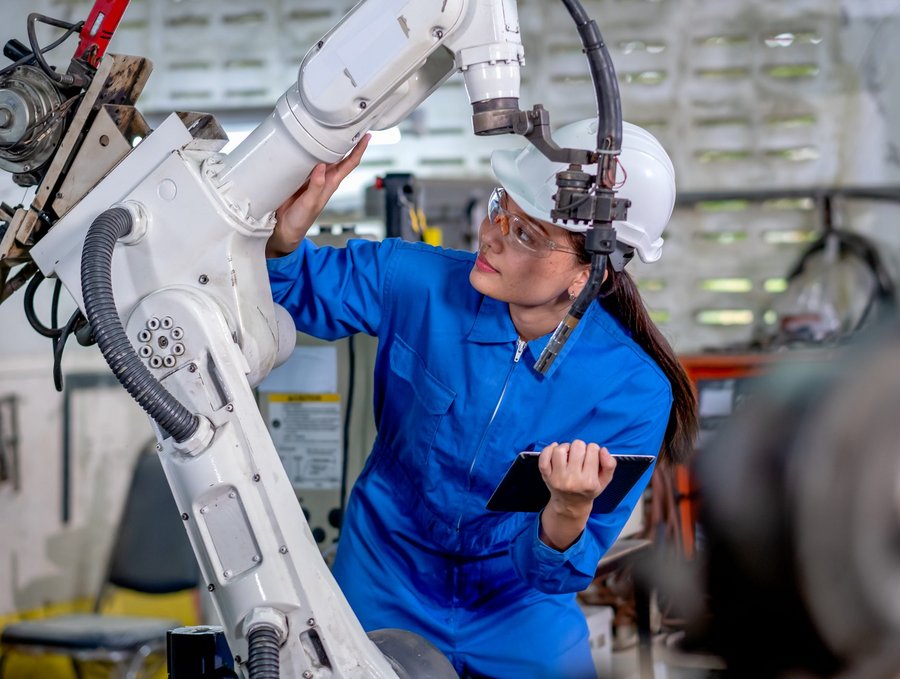Aaron Yeardley from Tunley Engineering provides insight into how AI reduces emissions in the operation of industry 4.0 solutions, including manufacturing.
Copyright: sustainabilitymag.com – “Artificial Intelligence drives the way to net-zero emissions”
 The fourth industrial revolution (Industry 4.0) is already happening, and it’s transforming the way manufacturing operations are carried out. Industry 4.0 is a product of the digital era as automation and data exchange in manufacturing technologies shift the central industrial control system to a smart setup that bridges the physical and digital world, addressed via the Internet of Things (IoT).
The fourth industrial revolution (Industry 4.0) is already happening, and it’s transforming the way manufacturing operations are carried out. Industry 4.0 is a product of the digital era as automation and data exchange in manufacturing technologies shift the central industrial control system to a smart setup that bridges the physical and digital world, addressed via the Internet of Things (IoT).
Industry 4.0 is creating cyber-physical systems that can network a production process enabling value creation and real-time optimisation. The main factor driving the revolution is the advances in artificial intelligence (AI) and machine learning. The complex algorithms involved in AI use the data collected from cyber-physical systems, resulting in “smart manufacturing”.
The impact that Industry 4.0 will have on manufacturing will be astronomical as operations can be automatically optimised to produce increased profit margins. However, the use of AI and smart manufacturing can also benefit the environment. The technologies used to optimise profits can also be used to produce insights into a company’s carbon footprint and accelerate its sustainability. Some of these methods are available to help companies reduce their GHG emissions now. Other methods have the potential to reduce global GHG emissions in the future.
Scope 3 Identification
Scope 3 emissions are the emissions from a company’s supply chain, both upstream and downstream activities. This means scope 3 covers all of a company’s GHG emission sources except those that are directly created by the company and those created from using electricity. It comes as no surprise that on average Scope 3 emissions are 5.5 times greater than the combined amount from Scope 1 and Scope 2. Therefore, companies should ensure all three scopes are quantitated in their GHG emissions baseline.[…]
Read more: www.sustainabilitymag.com
Thank you for reading this post, don't forget to subscribe to our AI NAVIGATOR!


Aaron Yeardley from Tunley Engineering provides insight into how AI reduces emissions in the operation of industry 4.0 solutions, including manufacturing.
Copyright: sustainabilitymag.com – “Artificial Intelligence drives the way to net-zero emissions”
Industry 4.0 is creating cyber-physical systems that can network a production process enabling value creation and real-time optimisation. The main factor driving the revolution is the advances in artificial intelligence (AI) and machine learning. The complex algorithms involved in AI use the data collected from cyber-physical systems, resulting in “smart manufacturing”.
The impact that Industry 4.0 will have on manufacturing will be astronomical as operations can be automatically optimised to produce increased profit margins. However, the use of AI and smart manufacturing can also benefit the environment. The technologies used to optimise profits can also be used to produce insights into a company’s carbon footprint and accelerate its sustainability. Some of these methods are available to help companies reduce their GHG emissions now. Other methods have the potential to reduce global GHG emissions in the future.
Scope 3 Identification
Scope 3 emissions are the emissions from a company’s supply chain, both upstream and downstream activities. This means scope 3 covers all of a company’s GHG emission sources except those that are directly created by the company and those created from using electricity. It comes as no surprise that on average Scope 3 emissions are 5.5 times greater than the combined amount from Scope 1 and Scope 2. Therefore, companies should ensure all three scopes are quantitated in their GHG emissions baseline.[…]
Read more: www.sustainabilitymag.com
Thank you for reading this post, don't forget to subscribe to our AI NAVIGATOR!
Share this: